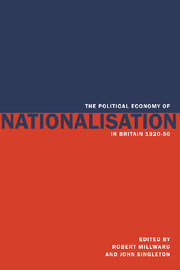Book contents
- Frontmatter
- Contents
- List of tables
- List of contributors
- Preface
- I Government and industry 1920–50
- II Case studies of industry organisation, performance and nationalisation
- III Government and the process of industrial change in the 1940s
- IV Review and Conclusions
- 14 The ownership of British industry in the post-war era: an explanation
- Index
14 - The ownership of British industry in the post-war era: an explanation
Published online by Cambridge University Press: 07 May 2010
- Frontmatter
- Contents
- List of tables
- List of contributors
- Preface
- I Government and industry 1920–50
- II Case studies of industry organisation, performance and nationalisation
- III Government and the process of industrial change in the 1940s
- IV Review and Conclusions
- 14 The ownership of British industry in the post-war era: an explanation
- Index
Summary
By the end of the 1940s the boundary between public and private economic activities in Britain had shifted decisively. One half of annual capital expenditure in the UK was undertaken in the public sector of which some 40 per cent was accounted for by the nationalised industries. This was the pattern for the next thirty years. The Conservative government which came to power in 1951 denationalised iron and steel along with road haulage. Later, in the 1960s and 1970s, airports and parts of the motor vehicle industry – Rolls-Royce, British Leyland – were brought into public ownership whilst iron and steel were renationalised. But the rest was untouched and the boundary had therefore remained unchallenged. Not until the 1980s did matters change. How then can we explain the particular constellation of private and public industry at the end of the 1940s? How can we resolve the puzzles left over from chapter 1? James Meade, argued in a memorandum for the Lord President's Economic Section that grounds for nationalisation were market concentration, capital intensity, senility (Howsen, vol. II, pp. 52–3): how close was this to the experience of the following five years?
To start with, let us underline the key factors influencing government industrial policies over the thirty years 1920–50. In the inter-war period the high unemployment levels and the falling value of the currency reflected the decline of the staple industries and the general loss of business to Germany, Spain, the USA and the new industrial competitors in Eastern Europe and Asia.
- Type
- Chapter
- Information
- The Political Economy of Nationalisation in Britain, 1920–1950 , pp. 309 - 320Publisher: Cambridge University PressPrint publication year: 1995



